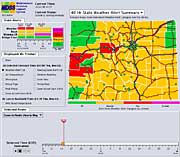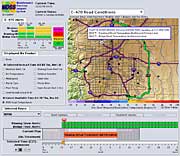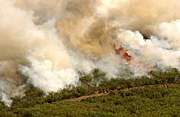
skip to content program navigation
| Learn more about these WEATHER RESEARCH areas... |
Winter and Other Hazardous Weather
Maybe you're one of those people who welcome the first few snow flakes as a sign that ski season is upon us. And while winter weather does offer many recreational opportunities, winter storms can be a gigantic inconvenience or worse, shutting down airports, causing dangerous driving conditions, closing schools and posing a significant danger to the public. And in addition to the hazards of winter weather, many communities must deal with floods, fire weather, lightning and other risky weather conditions. Here are some of the projects NOAA researchers are working on to make dangerous weather situations a little safer:
Winter Weather
At NOAA's National Severe Storms Laboratory (NSSL) in Norman, OK, researchers have been studying precipitation as part of the Intermountain Precipitation Experiment (IPEX), a field and research program designed to improve the understanding, analysis, and prediction of precipitation and precipitation processes in complex terrain. Results from this study are still being studied and analyzed.
What's the difference between sleet, freezing rain and snow squalls? Check out NSSL's web page which includes general information on winter weather.
Icing
At a division of the Earth System Research Laboratory, scientists have been studying how icing forms within clouds and how the conditions can be detected remotely to assist pilots when flying through these hazardous conditions. Results from this program, WISP-04, or the Winter Icing and Storms Project, are in the process of being analyzed.
Snow Removal
Researchers at Earth System Research Laboratory, along with other research partners, are developing a software package to help winter road crews in Iowa make decisions about snow removal on the highways. This work is done in support of the Maintenance Decision Support System (MDSS) project sponsored by the Federal Highways Administration. MDSS takes automated weather observations and forecasts and makes recommendations as to when to plow and/or make chemical applications on the roads. So far, they've saved the state of Iowa over a million dollars in a demonstration project testing the innovative system
Fire Weather
Fire weather is another hazardous condition that has been in the news frequently, especially during the last few years when drought conditions have been rampant across the Western U.S. A division of the Earth System Research Laboratory has developed a new workstation that assists forecasters when forecasting fire weather. Called FX-NET, the workstation has been used by meteorologists in the field, even in the midst of fires. It displays a variety of weather information including wind direction and speed, which is of special significance when forecasting fire weather conditions. The system is used by the National Weather Service (NWS) Incident Meteorologists (IMETS) , who are specially certified to deploy to the fire location and forecast the weather for the fire fighting control managers. The IMETS set up near the fire using the laptop system and a satellite communications system that allows them to get access to the Internet and to NWS weather information.
Air Quality
Smoggy, polluted air is becoming more and more of a problem for cities around the U.S. Many groups are working on various aspects of this problem. NOAA and the Environmental Protection Agency (EPA) have been working on a common Air Quality model for several years. In order to provide this model with the necessary data, ESRL has developed an FX-Net workstation (see workstation description in the Fire Weather section) specifically for the air quality forecasters. The EPA FX-Net Pilot project is in its second year with more than 80 EPA, state and local air quality researchers and forecasters using the system.
Lightning
Each year we read about someone who has been struck by lightning when out hiking, playing golf or doing other recreational activities. NSSL has been involved in lightning research for many years. Look over the NSSL lightning page which has extensive lightning statistics, safety information, and research activities.
Floods
Floods are among the most common and widespread of all natural disasters-except for fire. Floods can occur after heavy rains, hurricanes, heavy thunderstorms or winter snow thaws. Each year, floods claim over 100 lives and are responsible for more damage to property each year than any other type of weather. The National Severe Storms Laboratory (NSSL) conducts research on floods and other severe weather. The National Weather Service (NWS) issues watches and warnings for flooding and flash floods and issues a national hydrologic assessment that is updated frequently, especially in the Spring. Over 90 per cent of all natural disasters include some flooding.
Automated weather observation and forecast tools being developed at FSL will help snow removal supervisors schedule crews for plowing, sanding, or salting operations.
Tools such as this 48-hour weather alert summary (above, larger image) and road condition status (below, larger image) provide decision-making tools for winter road crews.
FX-Net was used for fireweather support during the Coal Seam Fire in Glenwood Springs, Colorado in 2002.. |
NOAA Research programs that study Winter and Other Hazardous Weather
![]() Earth
System Research Laboratory (ESRL)
Earth
System Research Laboratory (ESRL)
![]() National Severe Storms Laboratory (NSSL)
National Severe Storms Laboratory (NSSL)
NOAA Operational Groups
NEXT -- Field Experiments




